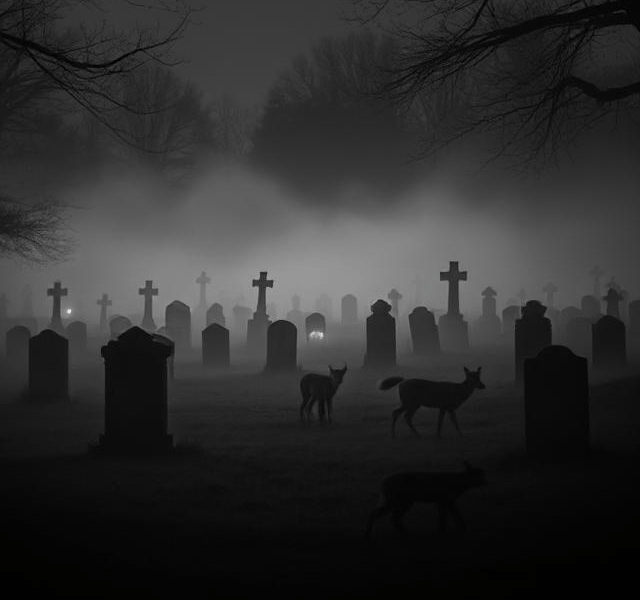Why Do Wild Animals Avoid Cemeteries? Eerie Theories Explored
Explore the mysterious phenomenon of wild animals avoiding cemeteries. This article delves into eerie theories—from unusual electromagnetic fields and odor cues to folklore and environmental factors—that might explain why these solemn grounds seem to repel wildlife.
DipVai
2/7/20253 min read


Cemeteries have long been shrouded in mystery and superstition, often depicted in folklore as places imbued with strange energies. One curious observation is that wild animals tend to steer clear of these hallowed grounds. While some attribute this behavior to supernatural influences, modern science offers a range of intriguing explanations that blend natural phenomena with cultural lore. Moreover, several real-life instances have added fuel to the debate.
Environmental and Olfactory Factors
One of the simplest theories is that cemeteries offer an environment that is distinctly different from typical natural habitats. Many cemeteries are meticulously maintained with manicured lawns, trimmed shrubs, and carefully laid walkways. This highly controlled landscaping may not appeal to wildlife that thrives in wild, untamed environments. Additionally, the presence of embalming chemicals and the natural decomposition process can produce odors that are off-putting to animals. For instance, some wildlife researchers in rural parts of the United States have noted that small mammals and insects seem to avoid cemetery areas, potentially due to these chemical and odor cues.
Electromagnetic and Atmospheric Considerations
Another theory involves the possibility that cemeteries generate unusual electromagnetic fields. In some cases, the dense concentration of headstones, monuments, and underground burial chambers might alter local electromagnetic or geophysical conditions. While scientific evidence is still emerging, there have been anecdotal reports from areas in Europe where sensitive species, like certain birds and small mammals, appeared to be less active in cemetery grounds compared to nearby parks. Residents in parts of Japan have also observed that birds such as crows and pigeons often avoid historic cemeteries, prompting locals to speculate whether subtle electromagnetic shifts are at play.
Folklore and Cultural Influences
Throughout history, many cultures have imbued cemeteries with a sense of mystery and reverence. In folklore, cemeteries are sometimes thought to be haunted or imbued with negative energies. Although such beliefs are not scientifically substantiated, they influence how these spaces are managed. For example, in some Mediterranean regions, strict maintenance routines—rooted in cultural traditions—ensure that cemeteries remain pristine and may inadvertently create an environment that is less attractive to wildlife.
Real-Life Instances: Evidence from the Field
Several documented cases add weight to these theories. In one instance, wildlife biologists in rural England noted that a local cemetery was noticeably devoid of common animals such as rabbits and hedgehogs, despite their abundance in adjacent natural areas. Similarly, in New England, researchers recorded lower levels of activity among small mammals and birds in a well-known cemetery compared to nearby forests and meadows. These observations suggest that the unique environmental conditions of cemeteries—whether due to landscaping, chemical residues, or electromagnetic anomalies—might indeed be influencing animal behavior.
In another striking case, residents near a centuries-old cemetery in Japan reported that migratory birds, particularly crows and sparrows, seemed to alter their flight paths to avoid the area entirely. Local naturalists documented these patterns over several migration seasons, noting a consistent trend that lent credence to the idea of an "avoidance zone" around these sites.
Behavioral Adaptations in Wildlife
Wild animals are highly sensitive to their environments, and their behavior is shaped by a complex interplay of instinct and learned responses. Over generations, animals may have learned to associate the atypical characteristics of cemeteries—be they unusual scents, electromagnetic disturbances, or even the lack of natural cover—with potential threats. This learned avoidance, whether instinctual or conditioned, could be an evolutionary adaptation aimed at steering clear of areas that might compromise survival.
Looking to the Future: Research and Exploration
The question of why wild animals avoid cemeteries remains open to further investigation. Advances in technology, such as high-resolution sensors and long-term ecological monitoring, are expected to provide more detailed insights into the environmental factors at play. Future studies may confirm whether these observed avoidance behaviors are indeed linked to measurable electromagnetic or olfactory cues, or if they are primarily driven by the structured nature of cemetery environments.
By integrating real-life observations with cutting-edge research, scientists hope to better understand how subtle environmental cues influence wildlife behavior. Such insights not only enhance our understanding of animal ecology but also inform how we manage and design human spaces to coexist harmoniously with nature.
A Mysterious Intersection of Nature and Culture
Whether driven by sensory cues, environmental conditions, or learned behaviors, the apparent aversion of wild animals to cemeteries remains a captivating subject. While science continues to unravel the mysteries behind this phenomenon, these eerie instances offer a glimpse into the complex interactions between human-made spaces and the natural world. As our research progresses, we may come to appreciate even more deeply how nature responds in unexpected ways to the environments we create.
Related Topics
Get in touch
itsusdipvai@gmail.com
